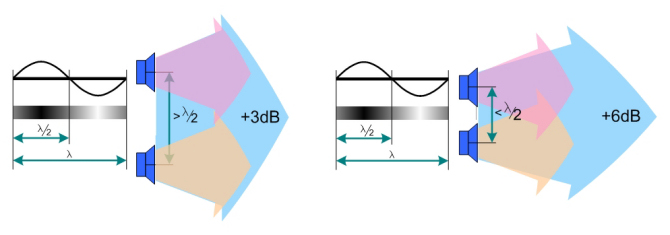
more than 1/2 wavelength separated
less than 1/2 wavelength separated
Mutual coupling of two or more loudspeakers occurs then they are reproducing th same signal with their acoustic centers close together and pointing in about the same direction at wavelengths smaller than the distance between the two centers. The combined sound signal is propagating forward like one single waveform, the two or more smaller drivers behave like one larger one.
The centers of two loudspeakers must be close enough together between 1/4 wavelength and 1/2 wavelength. The higher the wavelength the shorter the necessary distance between the two centers to build up mutual coupling.
The actual effect is always direction depending because of cancellations off-axis. Actually (theoretically) the coupling exactly on-axis occurs always independent of the spacing. At smaller wavelengths cancellation occurs earlier off-axis. At longer wavelengths the angle off-axis without strong cancellations is larger. The mutual coupling should be seen a an effect of the average sound level on-axis and off-axis. The acoustic centers' distance and the wavelength of the signal actually determine the angle over which mutual coupling occurs.

|
|
| no mutual coupling with acoustic centers more than 1/2 wavelength separated | mutual coupling with acoustic centers less than 1/2 wavelength separated |
With two loudspeakers next to each other at a distance of more than the wavelength of the reproduced frequency the average measured volume on-axis and off-axis adds up for +3dB (double power). With two loudspeakers close enough to get mutual coupling the volume adds up for +6dB.
Because of the physical size of loudspeaker chassis mutual coupling always occurs only at frequencies below about 500 Hz.